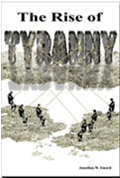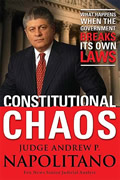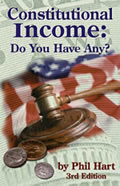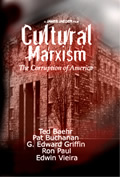A
CROSS OF DEBT
PART 1 of 4
By
Dr. Edwin Vieira, Jr., Ph.D., J.D.
February 10, 2012
NewsWithViews.com
[An highly abbreviated version of this paper was presented at the Committee for Monetary Research & Education Spring Meeting of 12 May 2011 in New York City.]
At the Democratic National Convention in 1896, Williams Jennings Bryan intoned: “You shall not crucify mankind on a cross of gold!” No society, though, has ever been crucified on a cross of gold—at least when gold functioned as actual money. But many have been crucified on a cross of debt—particularly when debt masqueraded as currency. And America is now on the road to her Golgotha, leading to her crucifixion. Being no saint myself, I am not inclined to say of those planning to perform this crucifixion: “Forgive them Father, for they know not what they do.” Because they know perfectly well what they are doing.
At base, the problem reduces to an alliance between two voracious crime families: avaricious bankers and financial speculators, on one side, in league with ambitious careerist politicians, on the other. Their strategy has always been to link the moneyed class with the government’s treasury, so as to advance the special interests of both families. The bankers and speculators incorporate the treasury as an integral part of their business plans. The politicians agree to coördinate the treasury with, if not subordinate it to, the bankers and speculators in order to ensure their own continuance in office. And the common people pay the costs.
This is an old scheme. Well before America’s War of Independence, in his Commentaries on the Laws of England, Sir William Blackstone trenchantly explained how it worked in the Mother Country. After discussing the “several branches of the revenue” under English law, Blackstone turned to how these sums were appropriated,
first and principally, to the payment of the interest of the national debt.
In order to take a clear and comprehensive view of the nature of this national debt, it must first be premised, that after the [English] revolution [of 1688], when our new connexions with Europe introduced a new system of foreign politics, the expenses of the nation, not only in settling the new establishment, but in maintaining long wars, * * * increased to an unusual degree: insomuch that it was not thought advisable to raise all the expenses of any one year by taxes to be levied within that year, lest the unaccustomed weight of them should create murmurs among the people. It was therefore the policy of the times to anticipate the revenues of their posterity, by borrowing immense sums for the current service of the state, and to lay no more taxes upon the subject than would suffice to pay the annual interest of the sums to be borrowed: by this means converting the principal debt into a new species of property, transferrable from one man to another at any time and in any quantity. * * * This laid the foundation of what is called the national debt * * * .
By this means the quantity of property in the kingdom is greatly increased in idea, compared with former times; yet if we coolly consider it, not at all increased in reality. We may boast of large fortunes, and quantities of money in the funds. But where does this money exist? It exists only in name, in paper, in public faith, in parliamentary security: and that is undoubtedly sufficient for the creditors of the public to rely on. But then what is the pledge, which the public faith has pawned for the security of these debts? The land, the trade, and the personal industry of the subject; from which the money must arise that supplies the several taxes. In these therefore, and these only, the property of the public creditors does really and intrinsically exist: and of course the land, the trade, and the personal industry of individuals, are diminished in their true value just so much as they are pledged to answer. * * * In short, the property of a creditor of the public consists in a certain portion of the national taxes: by how much therefore he is the richer, by so much the nation, which pays these taxes, is the poorer.
The only advantage, that can result to a nation from public debts, is the encrease of circulation by multiplying the cash of the kingdom, and creating a new species of money, always ready to be employed in any beneficial undertaking, by means of it’s transferrable quality; and yet producing some profit, even when it lies idle and unemployed. A certain proportion of debt seems therefore to be highly useful to a trading people; but * * * [t]his much is indisputably certain, that the present magnitude of our national incumbrances very far exceeds all calculations of commercial benefit, and is productive of the greatest inconveniences. For, first, the enormous taxes, that are raised upon the necessaries of life for the payment of the interest of this debt, are a hurt both to trade and manufactures, by raising the price as well of the artificer’s subsistence, as of the raw material, and of course, in a much greater proportion, the price of the commodity itself. Secondly if part of this debt be owing to foreigners, either they draw out of the kingdom annually a considerable quantity of specie for the interest; or else it is made an argument to grant them unreasonable privileges in order to induce them to reside here. Thirdly if the whole be owing to subjects only, it is then charging the active and industrious subject, who pays his share of taxes, to maintain the indolent and idle creditor who receives them. Lastly, and principally, it weakens the internal strength of a state, by anticipating those resources which should be reserved to defend it in case of necessity. The interest we now pay for our debts would be nearly sufficient to maintain any war, that any national motives could require.[1]
This system of not “rais[ing] all the expenses of any one year by taxes to be levied within that year, lest the unaccustomed weight of them should create murmurs among the people”, plainly proceeded from distrust that the people would actually agree with their governors that the “unaccustomed weight” of taxation the officials wanted them to bear was justified—which reflected either a malign opinion of the people’s intelligence, or the officials’ guilty consciences that the people were right. The “funding” scheme operated under the deception of “anticipat[ing] the revenues of [the people’s] posterity, by borrowing immense sums for the current service of the state, and * * * lay[ing] no more taxes upon the subject than would suffice to pay the annual interest of the sums to be borrowed”—while shifting the “unaccustomed weight” of taxation to unknown individuals in some distant future, individuals who neither were represented nor were capable of being represented in the Parliament which imposed such burdens on them. And, ultimately, this system manifested the contempt in which officialdom held both the present and future generations of citizens: the present generation, as greedy fools ever ready to pile their own burdens onto the backs of posterity; future generations, as fit subjects for the very epitome of tyranny, “taxation without representation”.
As Blackstone pointed out, the British “funding” system “convert[ed] the principal debt into a new species of property”: a claim by the public creditors on “[t]he land, the trade, and the personal industry of the [people]; from which the money must arise that supplie[d] the * * * taxes” to pay interest on the debt. This “new species of property” amounted to alienation by the present generation of politicians to the public creditors of the labor of future generations of workers, without those workers’ knowledge, let alone consent. Future generations were condemned, without votes or even a hearing, to be born with crushing burdens already laid upon their backs, their lives mortgaged to the involuntary servitude of paying perpetual taxes to defray perpetual interest on perpetual indebtedness. This was a formula for intergenerational serfdom, and for irreconcilable class conflicts that would inevitably and inexorably lead to a national disaster: the public creditors in the present seeking to expand the national debt and bring more and more private resources under governmental control so as to assure the payment of interest; the taxpayers in the future seeking to limit the disappearance of social wealth into the black hole of political redistribution before the national economy collapsed—and the struggle raging until either the debt crushed the country, or the country somehow repudiated the debt.
Upon her separation from Great Britain, America did not distance herself from the Mother Country’s “funding” scheme. To the contrary: The tainted genius of Alexander Hamilton, as the first Secretary of the Treasury, fastened that incubus onto this country’s throat, from which it has sucked America’s lifeblood since then. In the estimation of historian Claude Bowers, Hamilton
hoped to “array property on the side of the Government,” by giving it a financial interest in the Government, and “to assure to the property of the country a powerful influence upon the Government.” Having “been unable to introduce a class influence into the Constitution by limiting the suffrage . . . with a property qualification,” he hoped through his financial system to accomplish his purpose in another way.* * * His obsession was a strong, stable government—and to sustain it he required the interested devotion of the propertied class.[2]
By itself, the “funding” scheme was bad enough. Worse yet, Hamilton’s system included not only permanent public indebtedness, but also a nascent national bank—the first Bank of the United States—intended to assert control over the nation’s currency by creating “money” out of nothing through the financial card-trick of fractional reserves. Although sometimes met with strong political resistance—as during the Jacksonian era, when the second Bank of the United States was disestablished—Hamilton’s system gradually expanded in institutional scope and power with the creation of the National Banking System in the 1860s and then the Federal Reserve System in 1913. Upon the complete integration of bank and state arrived the potential for—indeed, in light of fallen human nature, the certainty of—the elephantiasis of public indebtedness. For the encouragement of which, propagandists during Franklin Roosevelt’s New Deal broadcast the Keynesian apology that no amount of public debt is really a burden because “we owe it to ourselves”. Unfortunately, the truth of the matter is that “we” do not owe it “to ourselves”. Rather, some Americans, present and future, supposedly owe it to a different group composed of both Americans and foreigners. Effectively, the public debt mortgages the property and productive capacity of the entire country to the speculators in government paper and the money-managers whose control over paper currency and bank-credit enables that debt to be floated on the froth of Ponzi finance.
The grotesque size of the National debt which Americans now purportedly owe as a consequence of the actions of their putative “representatives” in Congress—and the impossibility of this sum’s ever being paid in real terms—should by now have awakened every thinking person to the realization that Hamilton’s system, as refined in technique and expanded in scope by Woodrow Wilson, Franklin Roosevelt, and their successors in office, has dragged this country into the worst financial crisis in its history.
| Subscribe to the NewsWithViews Daily News Alerts! |
More importantly yet, this crisis is not merely accidental, or coincidental, but the necessary, inevitable, inexorable, and even intended consequence of the operation of Hamilton’s system. As Hamilton’s opponent, Thomas Jefferson, warned the Americans of his day in words that should resonate even more vibrantly now: “the principle of spending money to be paid by posterity, under the name of funding, is but swindling futurity on a large scale”.[3] Today, it is no longer a matter of “swindling futurity on a large scale”; rather, the “swindling” has swelled to such a stupendous scale that numbers of near-astronomical magnitudes must be employed to describe it. For part two click nelow.
Click here for part -----> 1, 2, 3, 4,
� 2012 Edwin Vieira, Jr. - All Rights Reserved
Footnotes:
1,
Commentaries on the Laws of England (Philadelphia, Pennsylvania:
Robert Bell, American Edition, 4 Volumes & Appendix, 1771-1773),
Volume 1, at 325-328.
2,
Claude G. Bowers, Jefferson and Hamilton: The Struggle for
Democracy in America (Cambridge, Massachusetts: The Riverside Press,
1925), at 45 (footnotes omitted).
3,
Letter to John Taylor, Monticello, 28 May 1816, in The Works of
Thomas Jefferson, Paul Leicester Ford, Editor (New York, New York:
G.P. Putnam’s Sons, Federal Edition, 12 Volumes, 1904-1905), Volume
11, at 533.
4,
A frugal government is the financial speculators’ worst nightmare,
because then they would have to invest in private enterprises that,
lacking the ability to coerce customers into buying their products,
might fail.
5,
See 31 U.S.C. § 3102(b). And many investment funds open to the
public maintain public debt as significant parts of their portfolios.
6,
See The Federalist No. 10 (James Madison) (emphasis supplied): “By
a faction I understand a number of citizens, whether amounting to a
majority or a minority of the whole, who are united and actuated by
some common impulse of passion, or of interest, adverse to the rights
of other citizens, or to the permanent and aggregate interests of the
community.”
7,
This is a plan on which the Forces of Darkness have long cogitated.
See, e.g., the detailed charts between pages 150 and 151 in Hans Heymann,
Plan for Permanent Peace (New York, New York: Harper & Brothers
Publishers, 1941).
8,
See, e.g., the “conditionality”—or, perhaps more descriptive,
the dictate—the EU and the IMF have imposed on Ireland, commanding
the Irish government to extract a new property tax from homeowners within
the next year. [Link]
9,
U.S. Const. preamble (emphasis supplied).
10,
U.S. Const. preamble.
11,
U.S. Const. art. I, § 8, cl. 2.
12,
See U.S. Const. art. V.
13,
See U.S. Const. art. I, § 8, cl. 11.
14,
See U.S. Const. art. I, § 8, cl. 18.
15,
U.S. Const. art. I, § 8, cl. 2 (emphasis supplied).
16,
Amend. XIV, § 4 (emphasis supplied).
17,
See also 31 U.S.C. 3102(a) (emphasis supplied): “With the approval
of the President, the Secretary of the Treasury may borrow on the credit
of the United States Government amounts necessary for expenditures authorized
by law and may issue bonds of the Government for the amounts borrowed
* * * .”
18,
See U.S. Const. art. VI, cl. 2.
19,
Marbury v. Madison, 5 U.S. (1 Cranch) 137, 174 (1803). Accord, Knowlton
v. Moore, 178 U.S. 41, 87 (1900); Blake v. McClung, 172 U.S. 239, 261
(1898).
20,
See Bute v. Illinois, 333 U.S. 640, 653 (1948).
21,
Norton v. Shelby County, 118 U.S. 425, 442 (1886).
22,
U.S. Const. art. I, § 8, cl. 1.
23,
U.S. Const. art. I, § 8, cl. 1.
24,
U.S. Const. art. I, § 8, cl. 2.
25,
U.S. Const. art. IV, § 3, cl. 2.
26,
See the discussion of Hanauer v. Doane, 79 U.S. (12 Wallace) 342 (1871),
post.
27,
U.S. Const. art. I, § 8, cl. 1.
28,
Compare U.S. Const. amend. XIV, § 4 with art. I, § 8, cl.
2.
29,
See U.S. Const. art. IV, § 3, cl. 2.
30,
79 U.S. (12 Wallace) 342 (1871).
31,
Id. (12 Wallace) at 345 (emphasis supplied).
32,
Id. (12 Wallace) at 346, 347.
33,
See U.S. Const. art. III, § 3, cl. 1 and Ex parte Bollman, 8 U.S.
(4 Cranch) 75, 126 (1807).
34,
See 18 U.S.C. §§ 241 and 242.
35,
See Flemming v. Nestor, 363 U.S. 603 (1960).
36,
12 U.S.C. § 411.
37,
An Act To provide for the establishment of Federal reserve banks, to
furnish an elastic currency, to afford means of rediscounting commercial
paper, to establish a more effective supervision of banking in the United
States, and for other purposes, Act of 23 December 1913, CHAP. 6, §
30, 38 Stat. 251, 275.
38,
See, e.g., Thompson v. Butler, 95 U.S. 694 (1878).
39,
What effectively amounts to a “dirt dollar” would hardly
be such an innovation as it sounds. After all, silver and gold are simply
specific components of “dirt” (that is, earth or ground),
that happen to exhibit greater purchasing powers, ounce for ounce, in
the marketplace than most other components, such as zinc, copper, lead,
or iron. Yet some components of dirt—such as platinum, palladium,
rhodium, and rubidium—are more valuable, ounce for ounce, than
either silver or gold. So (all constitutional objections aside) if a
refined “dirt dollar” of silver or gold is legitimate, no
principled objection to an unrefined “dirt dollar” should
be tenable.
40,
U.S. Const. art. VI, § 3, cl. 2. and art. I, § 8, cl. 5, respectively.
41,
E,g., 31 U.S.C. § 5118(b) declares that “[t]he United States
Government may not pay out any gold coin”. It does not say that
the government may not pay out aliquots of public land.
42,
See Perry v. United States, 294 U.S. 330 (1935).
43,
See U.S. Const. art. I, § 8, cl. 17. See generally Bill Howard
and Bill Redd, Statehood: The Territorial Imperative (Helper, Utah:
Bookcliff Publishing, 2005).
44,
See U.S. Const. art. I, § 8, cl. 17.
45,
See U.S. Const. art. I, § 8, cl. 1.
46,
McCulloch v. Maryland, 17 U.S. (4 Wheaton) 316, 431 (1819).
47,
See Hylton v. United States, 3 U.S. (3 Dallas) 171 (1796). See also
Billings v. United States, 232 U.S. 261 (1914).
48,
See U.S. Const. art. I, § 8, cl. 1.












 Share
This Article
Share
This Article





